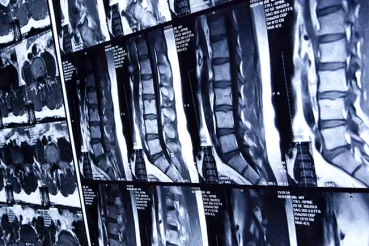Your back hurts? You're not alone.
Experts say low back pain is the second leading cause of missed days of work, behind only the common cold.
Roughly 75% to 80% of Americans will experience some form of back pain of during their lifetimes. This pain can be a symptom of many different causes, including overuse or improper use, strenuous activity, joint problems, smoking and obesity.
Most low back pain can effectively be treated without surgery. Many nonsurgical approaches for relieving back pain focus on reducing inflammation and restoring proper function and strength to the back.
If you seek relief from acute low back pain, here are five strategies that could help:
1. Over-the-counter pain medications.
Try taking acetaminophen, ibuprofen or naproxen. When it comes to low back pain, it's best to take these medications on a regular schedule rather than wait until pain becomes severe.
Just make sure you don't have any other health conditions or aren't taking any other medications that make taking ibuprofen or naproxen dangerous.
2. Rest.
Find a comfortable position, such as lying on your side with a pillow between your knees. Keep changing positions and, every couple hours, go for a walk.
Ultimately, activity is better for your back than rest, so limit the resting strategy to a day or two.
3. Ice or heat.
Some people find relief using heating pads or taking warm showers at regular intervals. Ice packs may also do the trick.
Apply ice or heat treatment for no more than 10 to 20 minutes each. Icing for any longer can cause more pain, and remember to never apply heat while asleep.
4. Walking.
Movement helps your muscles stay strong. The muscles of your trunk or core support your spine. Strengthening these muscles by walking or doing other exercises can decrease your chance of injury or pain.
5. Other types of exercise.
Aerobic exercise conditions your heart and other muscles, maintains health and speeds recovery.
Strengthening exercises that focus on your back, stomach and leg muscles can also help the back, as can stretching exercises to keep your muscles and other supporting tissues flexible and less prone to injury.
Ultimately, activity is better for your back than rest, so limit the resting strategy to a day or two.
Spinal surgery made simpler
In some cases, however, surgery is simply the best option. It's usually recommended if you continue to experience considerable pain despite nonsurgical treatments and if the cause of your back pain is due to something that can be surgically corrected.
Because every patient is unique, an evaluation by a spine specialist can help determine the right treatment for you.
The good news is that these days, surgery doesn't have to leave you sidelined for weeks or months.
"With minimally invasive techniques, we can have you up and running in a short time," says RUSH neurosurgeon John O'Toole, MD, MS. "Because of the faster recovery times, people are able to get back to work and other regular daily activities quicker than before."
The shorter recovery period, as well as smaller incisions and reduced blood loss make these procedures feasible for a broader range of back pain sufferers than traditional surgery — even some older adults who wouldn’t be candidates for more involved surgical procedures, O’Toole says.
Among the minimally invasive treatments is kyphoplasty, in which a doctor injects a glue-like substance to help stabilize and strengthen the bone.
Other surgical procedures include:
- Disc replacement, which involves removing a cervical or lumbar disc and replacing it with an artificial one
- Spinal fusion, in which vertebrae are fused together so they will heal into a single, solid bone
- Nucleoplasty, a minimally invasive procedure that uses radiofrequency energy to treat low back pain resulting from a mildly herniated disc
Is it serious?
Whether a nonsurgical or surgical approach is required, successful treatment starts with a proper diagnosis. O'Toole advises visiting your doctor any time you experience severe back pain.
"Once we've determined the underlying problem that’s causing the pain, we can then create a comprehensive treatment plan to address the problem." he says.
Look for these red flags to determine whether your back pain may signal more serious medical problems that should be assessed by a specialist:
- Low back pain that shoots into your legs. This may signal a neurological problem.
- Neck pain that shoots into your arms, which may be the result of a pinched nerve.
- Pain that worsens when you cough or sneeze.
- Inability to control your bowel function or urination.
- Difficulty urinating or passing a bowel movement.
- A diagnosis of osteoporosis. For people with weakened bones, back pain may indicate a fracture.
- Persistent or debilitating pain.
- A history of cancer, for which back pain might indicate metastasis.
"Whatever you do, don't ignore these symptoms," O'Toole cautions. "The earlier problems are diagnosed, the more successfully they can be treated. And, conversely, the longer problems are left untreated, the more serious the health consequences may be."




